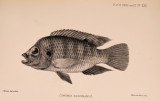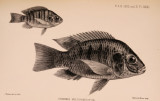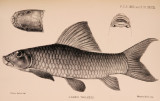| OCR Text |
Show 37G MR. W. F. LANCHESTER ON THE [Dec. 2, Tlie outer maxilla has a deep incision in its edge, at the bottom of which is a spine, externally to it three spines, and internally seven spines ; the inner maxilla is ovoid, with long hairs on its outer surface. The peduncle is equal to, or sometimes a little shorter than, the capitulum in length. V a r ia t io n s . This species is very variable in external appearance, one or two of the specimens appearing at first sight to be specifically distinct; but I have no doubt, from a comparison of all the specimens here present, that they are all of one species. These variations are connected with differences in the structure of the membrane, and the form and shape of the valves. (i) The Membrane. The membrane varies, both in the peduncle and capitulum, from the one extreme, in which it is thin, whitish, and translucent, to the other, in which it is thick, brown (in fonnol), and opaque, with the valves almost invisible; transitional stages connect these two extremes. (ii) The Valves. The tergum is generally shaped like the head and neck of a horse, as described, and formed of a single piece, but varies to the extreme shown in fig. 7 b. In two young forms also, with transparent membrane, the head proper is reduced and the neck thickened, giving an appearance as in fig. 7 c. In one specimen the base of the neck is formed of a very small separate double piece. The scutum is generally as described; biit the basal segment, generally as high as wide, is sometimes less developed, and is then much wider than it is high. The basal segment is also very variable in the number of pieces of which it is formed, thus:- Individual specimens : basal segment of scutum : (a) Very small, calcified separate portions are present-one at the baso-lateral, and two others at the tergal, angles. (b) Formed of two pieces-a small umbonal, and a large distal (tergal). (c) Formed of three distinct pieces- (1) a relatively small piece round the umbo of the valve; (2) a large piece, including the basal, and a little more than half of the tergo-lateral, margins; (3) a piece, intermediate in size, including the rest of the tergo-lateral, and the whole of the occludent, margins. The line of the tergo-lateral margin is markedly irregular. (d) On the right side (in relation to the animal) of three pieces as in c ; on the left side of two pieces, a large umbonal and somewhat smaller distal (tergal), the suture between them running irregularly from the middle of the tergo-lateral, to the middle of the occludent, margins. The carina is constantly formed of two |
































































































































































































































































































































